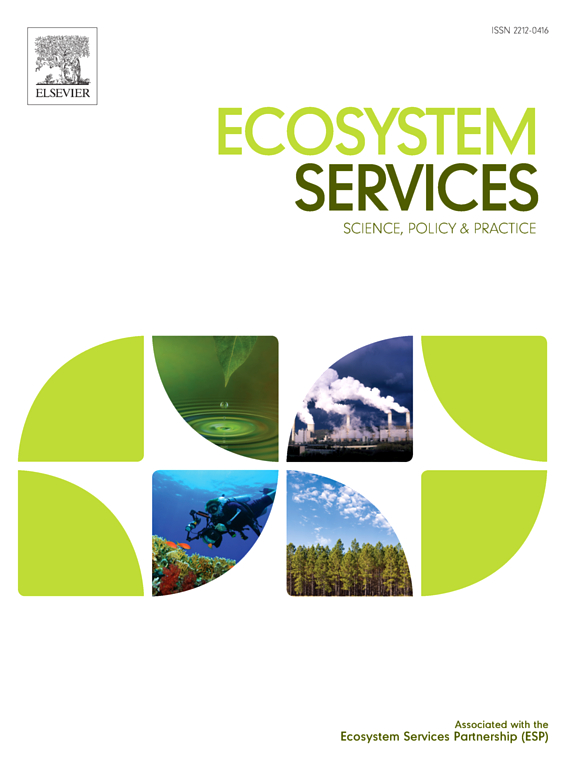Navigating trade-offs in carbon storage, biodiversity, and wildfire risk in European landscape management
IF 6.6
2区 环境科学与生态学
Q1 ECOLOGY
引用次数: 0
Abstract
Land use and climate change are driving new dynamics for wildfires and ecosystems globally. In Europe, these drivers contribute to changes in fuel structures which affect the behavior, impact, and recurrence interval of wildfires. In response, there is interest in restoring historic fuel-relevant land management strategies and fire regimes which impact the condition and arrangement of fuels. Simultaneously, ecosystem function (e.g., carbon storage and biodiversity) is a cornerstone for European sustainability and climate adaptation policies such as the Green Deal. Thus, a nuanced approach to landscape management is needed which addresses wildfires concerns while also conserving ecosystem function. Research evaluating the interaction between wildfire and ecological function in Europe has largely been limited to local or regional assessments which can be difficult to translate to European-wide policy initiatives. Our study takes a continental perspective to map areas in which ecosystem function and wildfire may be interacting using data on recent fire activity, aboveground carbon, and biodiversity. We synthesize policy-level considerations for mindfully navigating fire and conservation goals and propose areas which may be suitable for herbivory, mechanical removal, and prescribed burn to manage fuels. Our results highlight several countries, especially in eastern Europe and the Mediterranean, with both high ecosystem function and high fire activity which must be carefully managed to avoid intense and destructive fires in areas of high ecosystem function. Conversely, we identify areas with high fire activity and low carbon storage or biodiversity which may be good candidates for more intensive fuel management with fewer negative ecological consequences. As Europe continues to look to its landscapes to provide a wide range of services, policymakers will need to carefully consider services provided by landscapes to safeguard environmental objectives while managing the deleterious consequences of wildfires.

欧洲景观管理中碳储量、生物多样性和野火风险的权衡
土地利用和气候变化正在推动全球野火和生态系统的新动态。在欧洲,这些驱动因素导致燃料结构的变化,从而影响野火的行为、影响和复发间隔。因此,有兴趣恢复影响燃料状况和安排的与燃料有关的历史土地管理战略和消防制度。同时,生态系统功能(如碳储存和生物多样性)是欧洲可持续发展和气候适应政策(如绿色协议)的基石。因此,需要一种细致入微的景观管理方法,既能解决野火问题,又能保护生态系统功能。评估欧洲野火与生态功能之间相互作用的研究在很大程度上仅限于地方或区域评估,这些评估很难转化为全欧洲的政策举措。我们的研究采用大陆视角,利用最近的火灾活动、地上碳和生物多样性数据,绘制生态系统功能和野火可能相互作用的区域。我们综合了政策层面的考虑,以谨慎地导航火灾和保护目标,并提出了可能适合食草,机械清除和规定燃烧的区域来管理燃料。我们的研究结果强调了几个国家,特别是在东欧和地中海,具有高生态系统功能和高火灾活动,必须仔细管理,以避免在高生态系统功能地区发生强烈和破坏性的火灾。相反,我们确定了具有高火灾活动和低碳储存或生物多样性的地区,这些地区可能是更密集的燃料管理的良好候选者,并且负面生态后果较少。随着欧洲继续指望其景观提供广泛的服务,政策制定者将需要仔细考虑景观提供的服务,以保护环境目标,同时管理野火的有害后果。
本文章由计算机程序翻译,如有差异,请以英文原文为准。
求助全文
约1分钟内获得全文
求助全文
来源期刊

Ecosystem Services
ECOLOGYENVIRONMENTAL SCIENCES&-ENVIRONMENTAL SCIENCES
CiteScore
14.90
自引率
7.90%
发文量
109
期刊介绍:
Ecosystem Services is an international, interdisciplinary journal that is associated with the Ecosystem Services Partnership (ESP). The journal is dedicated to exploring the science, policy, and practice related to ecosystem services, which are the various ways in which ecosystems contribute to human well-being, both directly and indirectly.
Ecosystem Services contributes to the broader goal of ensuring that the benefits of ecosystems are recognized, valued, and sustainably managed for the well-being of current and future generations. The journal serves as a platform for scholars, practitioners, policymakers, and other stakeholders to share their findings and insights, fostering collaboration and innovation in the field of ecosystem services.
 求助内容:
求助内容: 应助结果提醒方式:
应助结果提醒方式:


